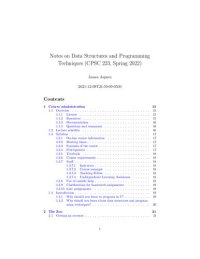
Ebook: Notes on Data Structures and Programming Techniques
Author: James Aspnes
- Genre: Computers // Algorithms and Data Structures
- Tags: data structures programming techniques
- Year: 2022
- Language: English
- pdf
Why should you learn about data structures and programming
techniques?
For small programs, you don’t need much in the way of data structures. But as
soon as you are representing reasonably complicated data, you need some place
to store it. Thinking about how you want to store and organize this data can be
a good framework for organizing the rest of your program.
Many programming environments will give you a rich collection of built-in data
structures as part of their standard library. C does not: unless you use third-
party libraries, any data structure you want in C you will have to build yourself.
For most data structures this will require an understanding of pointers and
storage allocation, mechanisms often hidden in other languages. Understanding
these concepts will give you a deeper understanding of how computers actually
work, and will both let you function in minimalist environments where you don’t
have a lot of support and let you understand what more convenient environments
are doing under their abstraction barriers.
The same applies to the various programming techniques we will discuss in this
class. While some of the issues that come up are specific to C and similar low-
level languages (particular issues involving disciplined management of storage),
some techniques will apply no matter what kinds of programs you are writing
and all will help in understanding what your computer systems are doing even if
some of the details are hidden.
techniques?
For small programs, you don’t need much in the way of data structures. But as
soon as you are representing reasonably complicated data, you need some place
to store it. Thinking about how you want to store and organize this data can be
a good framework for organizing the rest of your program.
Many programming environments will give you a rich collection of built-in data
structures as part of their standard library. C does not: unless you use third-
party libraries, any data structure you want in C you will have to build yourself.
For most data structures this will require an understanding of pointers and
storage allocation, mechanisms often hidden in other languages. Understanding
these concepts will give you a deeper understanding of how computers actually
work, and will both let you function in minimalist environments where you don’t
have a lot of support and let you understand what more convenient environments
are doing under their abstraction barriers.
The same applies to the various programming techniques we will discuss in this
class. While some of the issues that come up are specific to C and similar low-
level languages (particular issues involving disciplined management of storage),
some techniques will apply no matter what kinds of programs you are writing
and all will help in understanding what your computer systems are doing even if
some of the details are hidden.
Download the book Notes on Data Structures and Programming Techniques for free or read online
Continue reading on any device:

Last viewed books
Related books
{related-news}
Comments (0)